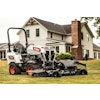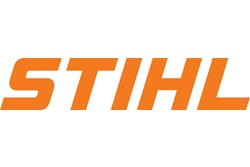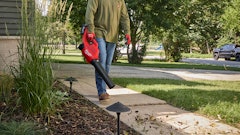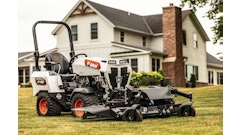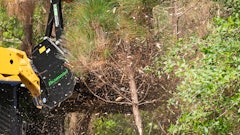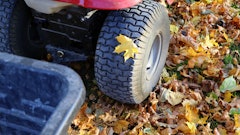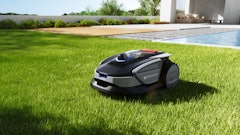Ease of Use
How quickly and easily a trimmer starts means getting to work as soon as you arrive at the jobsite. Manufacturers have designed starting procedures to be quick and intuitive. “We attempt to have starting that is simple with as few steps as possible,” says Marv Mathwig, product manager for power tools at Stihl Inc.
So what does it take to achieve near effortless starting? “Generally, a product that is easy to start contains an electronic ignition and a carburetor primer to reduce the number of pulls on the starter rope,” explains Gary Truman of Shindaiwa. “On larger, higher-cc products, the starter might include a spring-assisted system that reduces the force required to pull over the engine with the starter rope.”
It also goes beyond that. “Easy starting doesn’t necessarily mean easy pulling,” explains Gary Hardee of Husqvarna. “It needs to be intuitive.” Trimmer starting and throttle control, when intuitive, can increase efficiencies and reduce training time. Symbols and the location of controls all lend themselves to intuitive use, making it easy for an employee with little trimmer knowledge to get to work right away. This is especially important in a workforce heavily composed of H-2B workers who speak English as a second language.
The construction and location of controls should also enhance operator comfort. “The starter grip or handle needs to have smooth edges,” explains Hardee. “And the location of the starter rope out of the machine should be in line with the way the operator is going to use it, making it easier to pull.”
The overall weight of the trimmer and the even distribution of that weight can also make it more comfortable to operate, reducing user fatigue. “One of the most crucial factors for the landscaper is the power-to-weight ratio,” says Mathwig. “An operator is using the trimmer all day long for days at a time, so you want as much power as possible—and as little weight as possible. Balanced weight and ergonomic grips make it comfortable for use all day long.”
Shielding hands from the vibration of the machine also reduces operator fatigue. “Being able to isolate hands from the machine reduces the impact of vibrations,” says Hardee. “Many modern trimmers have a handle made of flexible material, or have isolating dampeners on the throttle handle that absorb some of the vibration.”
Power Means Performance
If a worker is comfortable using the unit all day long, it should be powerful enough to withstand the stresses of long use. “How well a unit functions depends on the amount of power it has,” says Mathwig. “Most landscapers are using units anywhere from one to two horsepower.” While there isn’t a huge power requirement needed for routine maintenance, more power is needed for trimming something for the first time.
Using the throttle to quickly increase the speed of the trimmer head increases jobsite efficiency for regular use and on the more challenging jobs. “It’s imperative that the trimmer has a good throttle response,” says Hardee. “The user has to be able to throttle-up very fast. They are going to be walking along, trimming, taking a few steps and then trimming again, up and down on the throttle the entire time. When you are idling and the head is not turning, you want it to immediately start turning when necessary.” The torque should automatically adjust to meet the challenge of the material it is cutting through, speeding up to cut better through the thicker grass.
As most in the power equipment industry are aware, engine emission regulations have continued to change how engines are made. “In October 2008, the Environmental Protection Agency (EPA) issued updated emissions regulations for small spark ignition (SI) engines, which include the handheld engines used on string trimmers,” says John Fischer, who has worked designing engine components and installations, most recently with Iveco Motors/FPT Powertrain. “With these new regulations, there are now evaporative emissions requirements in place which will minimize the amount of raw fuel that can find its way into the atmosphere.”
The challenge for manufacturers is keeping the engine powerful and prices comparable with the new environmentally friendlier construction. “To provide the user with greener, more environmentally responsible outdoor power equipment, Stihl technology provides lower emissions and increased fuel efficiency,” says Mathwig. “We are able to create more complete combustion of the fuel, thus better use of the fuel without decreases in power. But the new technology costs money so the new units could be more expensive.” The additional costs that could be incurred with the new technology should be offset by the additional fuel savings the user will see with proper use of the equipment.
“To indicate that the products are now fitted with low-permeation fuel tanks, there will be a label on the tank itself indicating compliance with the requirement,” explains Fischer. “And the special caps typically fitted to handheld products will now be tethered to reduce fuel spillage.”
Strength & Durability
The materials used to manufacture trimmers have been chosen for low fuel permeation as well as durability. “A unit needs to be able to take a beating,” says Mathwig. “You have to be able to run it hard and long with minimal downtime. The trimmer has to be able to continue performing day to day at high levels with proper maintenance.”
Where a consumer may be able to get by with purchasing some of the low-cost throwaway equipment, contractors should look for more carefully constructed equipment made of high-quality materials. The professional-grade equipment may come with a higher price tag, but it offers more value to the user with durability and features.
A covered engine, muffler and spark plugs protects vital trimmer components. What’s not covered should be durably constructed and carefully placed. “The on/off switch, throttle triggers and other mechanisms need to be somewhat flexible, made out of a bendable material,” explains Hardee. “That way it can take daily abuse.”
Surprisingly to some, using materials that are more durable has not added to the overall weight of the machine. “By going from traditional materials to magnesium and lightweight aluminum with the ability to add glass fibers for durability, the trimmer weights have actually gone down,” Hardee assures.
Growing Versatility
A growing trend in trimmers is interchangeable attachments. Ranging anywhere from a blower to a pole pruner, attachments make the trimmer a more versatile part of an equipment lineup. This type of product is offered by several manufacturers.
While this versatility has its advantages, the attachments system may not be the best choice for larger contractors with an established fleet. “Most of your commercial users are going to use dedicated machines,” says Hardee. “The people who buy the trimmer attachments are smaller contractors or those that are part-time and want to supplement their income. Instead of buying a trimmer and an edger at around $300 a piece, they can buy a $300 trimmer and a $100 edger attachment.”
For the user, the savings goes beyond cost. “There is also storage savings,” says Mathwig. “Plus, they only have to own and maintain one engine. It’s a very cost-effective way for the small contractor to do multiple tasks.”
Stihl offers a KombiSystem that features multiple power heads or engine units, and a split shaft with over 13 optional attachments available that can be changed on the jobsite without tools. “Workers can drive up to the jobsite and grab the KombiSystem out of the truck and pick up wherever they are needed,” Mathwig explains.
Purchasing a quality trimmer has only gotten easier as leading manufacturers continue to engineer products for improved power and versatility. Easy starting and enhanced operator comfort make a day on the jobsite easy to slice through, while reduced emissions and longer-lasting components help you get even more performance out of your trimmer.
Nine High-Performance Specs to Look For
> Starting system
> Construction, location of controls
> Power-to-weight ratio
> Vibration-dampening features
> Throttle response
> Engine emissions
> Fuel efficiency
> Construction, protection of vital components
> Ability to accept interchangeable attachments (if you need more versatility)



